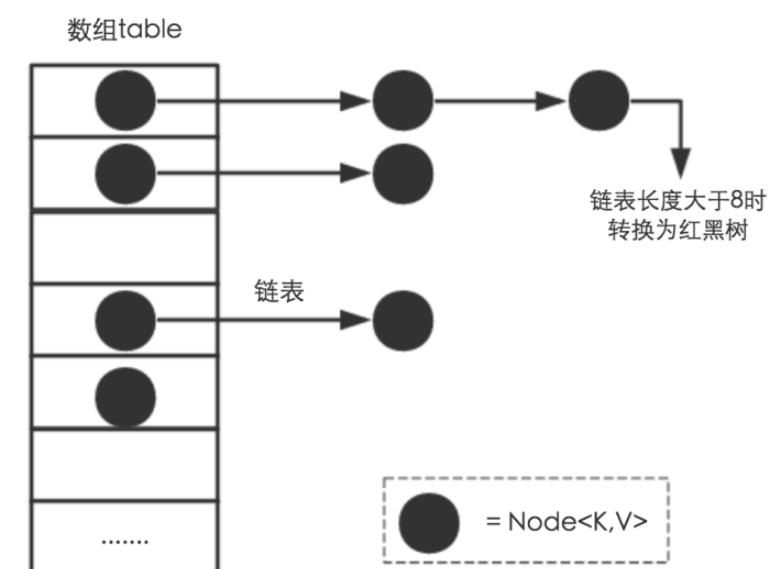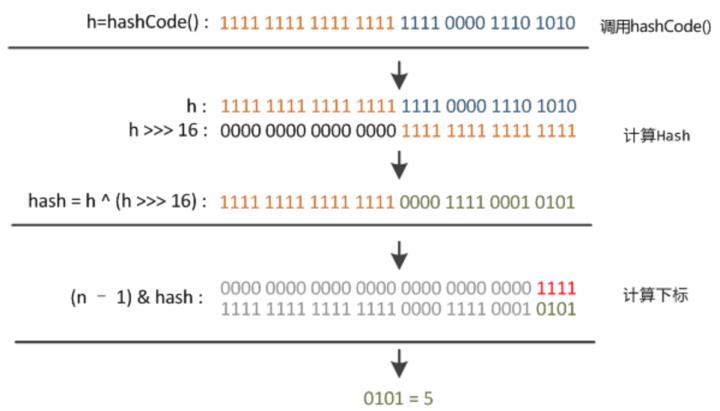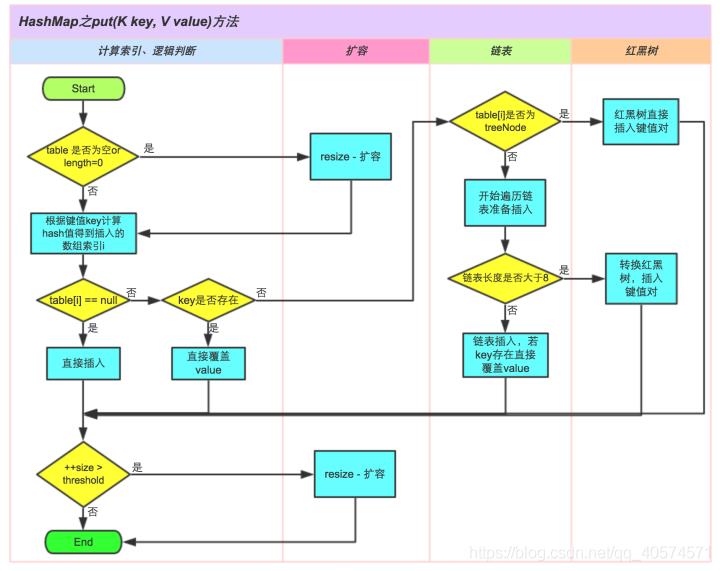浅读HashMap源码(java 1.8)
Posted 皓洲
tags:
篇首语:本文由小常识网(cha138.com)小编为大家整理,主要介绍了浅读HashMap源码(java 1.8)相关的知识,希望对你有一定的参考价值。
HashMap 学习笔记
存储结构(数据结构)
从结构实现来讲,HashMap是数组+链表+红黑树(JDK1.8增加了红黑树部分)实现的,如下如所示。

看下源码:
/**
* Basic hash bin node, used for most entries. (See below for
* TreeNode subclass, and in LinkedHashMap for its Entry subclass.)
*/
static class Node<K,V> implements Map.Entry<K,V> {
final int hash;//储存节点的hash值
final K key;//储存节点的key值
V value;//储存节点的value值
Node<K,V> next;//用于连接下一个node节点
Node(int hash, K key, V value, Node<K,V> next) {
this.hash = hash;
this.key = key;
this.value = value;
this.next = next;
}
public final K getKey() { return key; }
public final V getValue() { return value; }
public final String toString() { return key + "=" + value; }
public final int hashCode() {
return Objects.hashCode(key) ^ Objects.hashCode(value);
}
public final V setValue(V newValue) {
V oldValue = value;
value = newValue;
return oldValue;
}
public final boolean equals(Object o) {
if (o == this)
return true;
if (o instanceof Map.Entry) {
Map.Entry<?,?> e = (Map.Entry<?,?>)o;
if (Objects.equals(key, e.getKey()) &&
Objects.equals(value, e.getValue()))
return true;
}
return false;
}
}
HashMap的重要字段
在理解Hash和扩容流程之前,我们得先了解下HashMap的几个字段。从HashMap的默认构造函数源码可知,构造函数就是对下面几个字段进行初始化,源码如下:
//序列化id
private static final long serialVersionUID = 362498820763181265L;
//默认初始容量-必须为2的幂。
static final int DEFAULT_INITIAL_CAPACITY = 1 << 4; // aka 16
//最大容量为2的30次方
static final int MAXIMUM_CAPACITY = 1 << 30;
//默认负载因子为0.75,当数据大于容量值的75%时会进行扩容
static final float DEFAULT_LOAD_FACTOR = 0.75f;
//树化阈值,当一个链表长度达到8则链化成红黑树
static final int TREEIFY_THRESHOLD = 8;
//取消树化阈值,当一个红黑树节点达到6时则转成链表
static final int UNTREEIFY_THRESHOLD = 6;
//最小树形化容量阈值:即 当哈希表中的容量 > 该值时,才允许树形化链表 (即 将链表 转换成红黑树)
static final int MIN_TREEIFY_CAPACITY = 64;
功能实现 - 方法
HashMap的内部功能实现很多,本文主要从根据key获取哈希桶数组索引位置、put方法的详细执行、扩容过程三个具有代表性的点深入展开讲解。
1. 确定哈希桶数组索引位置
static final int hash(Object key) {
int h;
// h = key.hashCode() 为第一步 取hashCode值
// h ^ (h >>> 16) 为第二步 高位参与运算
return (key == null) ? 0 : (h = key.hashCode()) ^ (h >>> 16);
}
static int indexFor(int h, int length) { //jdk1.7的源码,jdk1.8没有这个方法,但是实现原理一样的
return h & (length-1); //第三步 取模运算
}
下面举例说明下,n为table的长度。

2. 分析HashMap的put方法
HashMap的put方法执行过程可以通过下图来理解

public V put(K key, V value) {
return putVal(hash(key), key, value, false, true);
}
/**
* 实现Map.put和相关方法。
*
* @param hash key的hash值
* @param key 键
* @param value 值
* @param onlyIfAbsent 如果当前位置已存在一个值,是否替换,false是替换,true是不替换
* @param evict 如果为false,则表处于创建模式。
* @return 返回上一个值,如果没有则返回null
*/
final V putVal(int hash, K key, V value, boolean onlyIfAbsent,
boolean evict) {
Node<K,V>[] tab; Node<K,V> p; int n, i;
//table为Hashtable表,p为当前值对应的表的节点
//n表示表的长度,i是值对应表的下标
// 步骤1:tab为空则创建
if ((tab = table) == null || (n = tab.length) == 0)
n = (tab = resize()).length;
// 步骤2:计算index,并对null做处理
if ((p = tab[i = (n - 1) & hash]) == null)
tab[i] = newNode(hash, key, value, null);
else {
Node<K,V> e; K k;
//e用来遍历节点p,k用来临时储存key值
// 步骤3:节点key存在,直接覆盖value
if (p.hash == hash &&
((k = p.key) == key || (key != null && key.equals(k))))
e = p;
// 步骤4:判断该链为红黑树
else if (p instanceof TreeNode)
e = ((TreeNode<K,V>)p).putTreeVal(this, tab, hash, key, value);
// 步骤5:该链为链表
else {
//遍历链表
for (int binCount = 0; ; ++binCount) {
if ((e = p.next) == null) {
p.next = newNode(hash, key, value, null);
//链表长度大于8转换为红黑树进行处理
if (binCount >= TREEIFY_THRESHOLD - 1) // -1 for 1st
treeifyBin(tab, hash);
break;
}
// key已经存在直接覆盖value
if (e.hash == hash &&
((k = e.key) == key || (key != null && key.equals(k))))
break;
p = e;
}
}
//存在key值和hash值相等的,直接覆盖旧value
if (e != null) { // existing mapping for key
//取出e的value
V oldValue = e.value;
if (!onlyIfAbsent || oldValue == null)
e.value = value; //覆盖
afterNodeAccess(e); //访问后回调
return oldValue;
}
}
++modCount;
// 步骤6:超过最大容量 就扩容
if (++size > threshold)
resize();
afterNodeInsertion(evict);
return null;
}
3.扩容机制
扩容(resize)就是重新计算容量,向HashMap对象里不停的添加元素,而HashMap对象内部的数组无法装载更多的元素时,对象就需要扩大数组的长度,以便能装入更多的元素。当然Java里的数组是无法自动扩容的,方法是使用一个新的数组代替已有的容量小的数组,就像我们用一个小桶装水,如果想装更多的水,就得换大水桶。
final Node<K,V>[] resize() {
Node<K,V>[] oldTab = table;
int oldCap = (oldTab == null) ? 0 : oldTab.length;
int oldThr = threshold;
int newCap, newThr = 0;
if (oldCap > 0) {
// 超过最大值就不再扩充了,就只好随你碰撞去吧
if (oldCap >= MAXIMUM_CAPACITY) {
threshold = Integer.MAX_VALUE;
return oldTab;
}
// 没超过最大值,就扩充为原来的2倍
else if ((newCap = oldCap << 1) < MAXIMUM_CAPACITY &&
oldCap >= DEFAULT_INITIAL_CAPACITY)
newThr = oldThr << 1; // double threshold
}
else if (oldThr > 0) // initial capacity was placed in threshold
newCap = oldThr;
else { // zero initial threshold signifies using defaults
newCap = DEFAULT_INITIAL_CAPACITY;
newThr = (int)(DEFAULT_LOAD_FACTOR * DEFAULT_INITIAL_CAPACITY);
}
// 计算新的resize上限
if (newThr == 0) {
float ft = (float)newCap * loadFactor;
newThr = (newCap < MAXIMUM_CAPACITY && ft < (float)MAXIMUM_CAPACITY ?
(int)ft : Integer.MAX_VALUE);
}
threshold = newThr;
@SuppressWarnings({"rawtypes","unchecked"})
Node<K,V>[] newTab = (Node<K,V>[])new Node[newCap];
table = newTab;
if (oldTab != null) {
// 把每个bucket都移动到新的buckets中
for (int j = 0; j < oldCap; ++j) {
Node<K,V> e;
if ((e = oldTab[j]) != null) {
oldTab[j] = null;
if (e.next == null)
newTab[e.hash & (newCap - 1)] = e;
else if (e instanceof TreeNode) //如果是红黑树节点
((TreeNode<K,V>)e).split(this, newTab, j, oldCap);
else { // 链表优化重hash的代码块
Node<K,V> loHead = null, loTail = null;
Node<K,V> hiHead = null, hiTail = null;
Node<K,V> next;
do {
next = e.next;
// 原索引
if ((e.hash & oldCap) == 0) {
if (loTail == null)
loHead = e;
else
loTail.next = e;
loTail = e;
}
// 原索引+oldCap
else {
if (hiTail == null)
hiHead = e;
else
hiTail.next = e;
hiTail = e;
}
} while ((e = next) != null);
// 原索引放到bucket里
if (loTail != null) {
loTail.next = null;
newTab[j] = loHead;
}
// 原索引+oldCap放到bucket里
if (hiTail != null) {
hiTail.next = null;
newTab[j + oldCap] = hiHead;
}
}
}
}
}
return newTab;
}
以上是关于浅读HashMap源码(java 1.8)的主要内容,如果未能解决你的问题,请参考以下文章